Aggressive Humanism
At the end of 2019, shortly after the European Commission gave Croatia the green light to join the Schengen Area, the Welcome Initiative set up two billboards next by the roadside in the Dalmatian town of Cista Provo featuring a photo of a severely injured young man: his face contorted in pain, his upper teeth missing, covering his eyes with a hand wrapped in a bloody bandage. The billboards were placed close to the border with Bosnia and Herzegovina, in a place reserved for artistic interventions in public space using large billboards. They remained a roadside fixture for several weeks, receiving some national media coverage in agency news. However, this higher visibility did not lead to public reactions and discussions.

By appropriating the tourist slogan “Welcome to Croatia” and paraphrasing the slogan “Croatia full of life” into “Croatia full of torture”, the billboards stood in stark contrast to the official state and promotional discourses relating to the pushbacks that are routinely carried at Croatian state borders out in secret. In other words, the (anti)slogans printed over a deformed male face were used to highlight the discrepancy between the openness of Croatian borders, as the borders of a European tourist destination, and their closedness, as the external borders of the EU. Thus, as pointed out in the statement addressed to the public, these billboards were aimed to convey “that the truth of refugees and migrants who are at the receiving end of police repression every day is stronger and louder than batons, flashing police lights and cells” and that “the people who suffer blows, insults and curses, who have come to know pain, hunger and fear, give a more credible account of our country than worn-out tourist slogans”.
Aside from the violence at the borders, the protest billboards also critically addressed the dominant victimization policies involved in the representation of violence at the borders, placing at its representation center an injured young man whose photo does not invite viewers to identify with him, nor does it automatically elicit empathy. Due to their politically engaging and non-conformist radical criticism of the violence of the European migration control regime, these billboards can also be seen as a kind of aggressive humanism in the sense of provocative, radically critical artistic and activist interventions aimed against repressive policies and practices, which seek to evoke strong reactions from the public (cf. von Bieberstein and Evrem 2016).
The term aggressive humanism, which appeared sporadically in different meanings in philosophical, literary criticism and related literature during the 20th century, was given a more precise meaning in this century when it was linked to migration by the Zentrum für Politische Schönheit (Center for Political Beauty), a German art-activist group which brings together artists, intellectuals, scientists, etc. In the group’s text which could be categorized as a manifesto of aggressive humanism, the Center for Political Beauty uses the examples of the persecution of Jews in the Second World War and the war in Bosnia and Herzegovina as starting points and promotes the idea that the dissemination of information about suffering and crimes cannot stop atrocities by itself, nor can it initiate a successful resistance. “Ultimately neither information nor images were able to curtail the horror of genocide,” the text states. The Center for Political Beauty is critical of the contemporary activist scene in Germany and the general impotence of activist interventions in democratic societies, and thus advocates the politics and poetics of aggressive humanism, which breaks with the benevolent and non-conflicting nature of humanism's placing the human at the center of political, activist and artistic activity. Through radical and critical action-based art (Aktionkunst), the Center for Political Beauty strives to bring the passion and force found in political activists of past generations back to the political and public scene. Their interventions include the notable and controversial multi-location operation Die Toten kommen (The Dead are Coming, 2015), which was performed as a reaction to the fact that contemporary Western societies lack interest in the border violence and border deaths.
Certain counter-memorialization practices and grief-activism actions on the Balkan route correspond with aggressive humanism to a greater or lesser extent. The actions of naming the Madina Hussiny Square in Zagreb, which were carried out in memory of a six-year-old Afghan girl who died during a pushback from Croatia to Serbia, and the memorial canvas for those who died at Croatian borders, Prijelaz / The Passage, are both expressions of mourning and protest against pushbacks and violence at Croatian borders.
10/3/2022
Literature
von Bieberstein, Alice and Erdem Evrem. 2016. "From Aggressive Humanism to Improper Mourning. Burying the Victims of Europe's Border Regime in Berlin". Social Research. An International Quarterly of the Social Sciences 83/2:453-479.